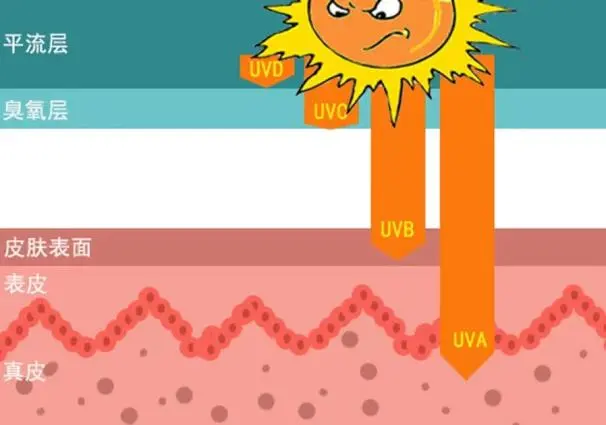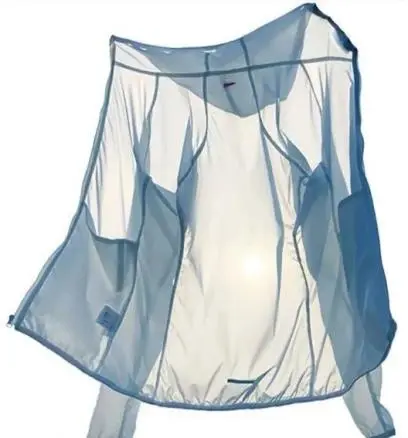As summer approaches, the sunlight grows stronger, making sun protection a focal point for many. In addition to applying sunscreen, an increasing number of people opt for wearing sun-protective clothing to shield their skin from UV damage. At the same time, many wonder whether sun-protective clothing feels no different from regular outerwear or even thinner, how can it “protect” from the sun? Is it genuinely effective or just a “tax on intelligence”?
How does sun-protective clothing work?
Before selecting suitable sun-protective clothing, let’s understand the principles behind it. Firstly, we know that sun-protective clothing shields against UV rays. Based on different biological effects, UV rays are divided into four bands from longest to shortest wavelength: UVA, UVB, UVC, and UVD. Due to atmospheric protection, UVC and UVD don’t reach the Earth’s surface, so protection against UV damage focuses on blocking UVA (which accelerates skin aging) and UVB (the primary cause of tanning).

When UV rays hit fabric, there are mainly three routes: reflection, absorption, and transmission. Reflection involves altering the propagation direction of UV rays at the fabric level through fabric weaving techniques or adding reflective heat-insulating materials, causing UV rays to return outward. Absorption involves fabric materials interacting with UV rays during penetration, gradually converting energy into other forms. Transmission refers to UV rays passing through the fabric.
Therefore, the working principle of sun-protective clothing primarily relies on two aspects: physical blocking and chemical protection.
Physical blocking: Sun-protective clothing is typically made from special textile materials with a tight weave structure, capable of blocking most UV rays from passing through. This physical barrier is similar to the function of a parasol or sunglasses, providing a protective layer for the skin and reducing the area directly exposed to sunlight.
Chemical protection: In addition to physical blocking, many sun-protective clothing items incorporate UV absorbers or reflectors during production. These chemicals absorb or reflect UV rays, further reducing their harm to the skin. This chemical protection layer allows sun-protective clothing to block UV rays while maintaining breathability and comfort.
How to choose sun-protective clothing?
In China, the basic requirement for sun protection textile products is to meet the national standard GB/T 18830-2009 “Evaluation of UV Protective Performance of Textiles”, which states that “UV protective textiles must achieve a UPF > 40, UVA transmittance < 5% to be called UV protective products.”
Therefore, when choosing sun-protective clothing, we primarily look at the following two indicators:
Ultraviolet Protection Factor (UPF): UPF value is an important indicator of the effectiveness of sun-protective clothing. It represents the ratio of the average effect of UV radiation on the skin without protection to that with fabric protection. The higher the UPF value, the better the UV protection of the textile product. However, consumers don’t need to blindly pursue high UPF values. A UPF value of 50 already provides high UV protection, and higher UPF values have little significance in improving UV protection.
UVA transmittance: UVA, with the longest wavelength in UV rays, has strong penetrating power and can reach the skin’s dermis layer, damaging elastic and collagen fibers. Therefore, the lower the UVA transmittance, the better the UV protection of the textile product.
Next, we consider the style. A widened brim can provide more comprehensive facial sun protection; high-necked designs with three-dimensional tailoring enhance protection while allowing for more convenient movement; additionally, designs with hidden pores under the armpits and on the back increase breathability and sweat wicking without compromising sun protection. Then, we consider the color. In situations where choices are available, sun-protective clothing in saturated colors performs better at reflecting UV rays than unsaturated colors. Therefore, choosing black or red tones is a superior choice for sun protection considerations.
How often should sun-protective clothing be replaced?
The lifespan of sun-protective clothing depends on various factors, including material, frequency of use, and cleaning methods. Generally, high-quality sun-protective clothing can last for several years under normal use and proper maintenance. However, several factors may affect the effectiveness and lifespan of sun-protective clothing:
Frequent washing: Frequent washing may gradually wear down the sun-protective layer of clothing, leading to reduced effectiveness. Therefore, unless necessary, frequent washing of sun-protective clothing is not recommended.
Exposure and wear: Prolonged exposure to sunlight and physical wear can also affect the performance of sun-protective clothing. If sun-protective clothing shows signs of fading, thinning fabric, or peeling of the chemical protective layer, it’s time to consider replacing it with new sun-protective clothing.
Maintenance: Proper maintenance can extend the lifespan of sun-protective clothing. Avoid using bleach and strong detergents, choose gentle washing methods, and follow the manufacturer’s instructions for maintenance.
In conclusion, sun-protective clothing is an effective sun protection tool that provides additional protection to the skin through both physical blocking and chemical protection. When selecting and using sun-protective clothing, attention should be paid to factors such as UPF value, material, comfort, and maintenance to ensure the best sun protection. Although purchasing sun-protective clothing incurs a certain cost, compared to its sun protection effectiveness and long-term health benefits, it is by no means an “intellectual tax”. By selecting and maintaining sun-protective clothing reasonably, we can effectively reduce UV damage to the skin while enjoying outdoor activities.
